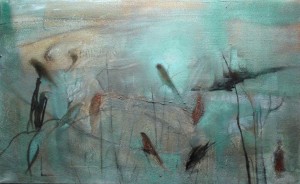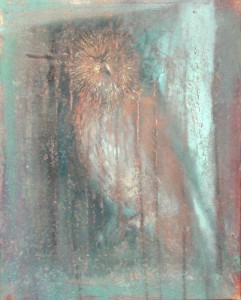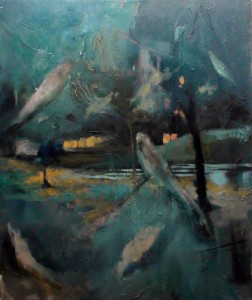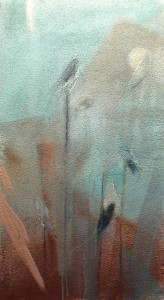Zoran Calija answers FAD’s Questions
1 When did you start to make art?
I started creating as a child, my first phase of creativity was the product of a game and also of communication with my inner fantasy world.

The year I was born, 1963, we had a horrible earthquake in Skopje, Macedonia so for the next 6 years we were living in barracks. There were no toys, my parents were often busy working so I was spending a lot of time playing with pencils and paper, and ever since then I believe that creativity – art has a strong link to childhood, and to create is to play.
At first I was drawing silhouettes of people, animals, I would cut them out and play with them, and later I made them from different materials, I drew comics, cartoons, I did all that as a child. When I was in 5th or 6th grade my cousin gave me my first illustration book by Van Gogh and I was so fascinated, if I had to name an artist who made such an impression on me in that early period that’d be Van Gogh and later also Boticelli, Bosch, Picasso, Dali.
2 How did you evolve into a professional artist?
When I was in elementary school my teachers noticed me, and later my art teacher did too, and so they would give me various tasks, not only in art class, but also the other teachers commissioned me, and since I wasn’t a very good student that came in handy for my grades – I painted Einstein and Newton for my physics teacher, Ivo Andric, Selimovic for my Serbian language teacher, some heroes from history for my history teacher.
Unruly as I was, in 7th grade I once skipped school to go to Ada Ciganlija, and I saw kids making sculptures in the sand. It was some sort of competition – everyone was with their teachers, and I thought I could win a candy or chocolate and I signed up. I won the first prize in Belgrade, third prize in Serbia, fifth in the former Yugoslavia, but there was no chocolate, just a certificate. Meanwhile I traded a drawing for a doctor’s note because I had skipped school, but I had no idea that a newspaper published a photo from the competition. So I also got detention and a warning before expulsion because I had lied and skipped school, but I also got praised for the prize I won.
Later I went to art high school and then the academy of art.
3 What drove you to make art as a professional vocation?
The answer to this is the answer to the question of what art is. And for me, art is the process of gathering information from the outside world with our senses, the integration with our inner world and the production of the piece.

It’s that feeling of inner joy and that inner feeling that can be materialized through artwork. The feeling of creation is vital. The joy of creating is the reason and the motor of my art.
4 Explain your inspiration?
The inspiration can be a strong emotional feeling, a strong visual sensation, a fantasy, playing, experimenting, and sometimes the combination of all these things. The inspiration is, for me, the infusion of creating, sometimes it comes from the outside world and sometimes from the inside, from the very being. Inspiration cannot be controlled easily, it’s like love, sometimes you wait for it for years, you call for it, and nothing comes, and then all of a sudden it shows up, it overwhelms you and becomes your master.
5 How does your inspiration transform itself into ideas?
There is no recipe for that, if there was one then there wouldn’t be creation and pleasure, it would be pure manual production labour. Sometimes the idea just shows up, then the inspiration comes along with it. Sometimes the inspiration comes first and then, guided by it, I search and experiment like an alchemist. And sometimes I just find myself in front of an enormous blank canvas and I attack it, looking for the inspiration and the idea.
6 From ideas to production of art – how? And why?
A painting is a process, there is no recipe, the approach to every painting is different, each painting is a unique being, just like each man is. Every painting, every artwork, has its character, just like every creature on this Earth has its own character. And to ask why, is like asking why to love.
7 Could your ideas be portrayed in any other medium? If so which?
Of course they can, but basically the most important thing is that the artist is true to his work. He has to have his inner story and his inner sensation and to be true to his art, and the medium through which he will produce it can be a sculpture, a poem, words, theatrical play, and the success of the productions depends on his skill and knowledge of the medium.
8 Which artists would you most like to blatantly rip off?
I enjoy the work of others, but I don’t feel the need to copy anyone.
9 Why is your art made?
Because it brings me joy when I succeed in materializing the synthesis of the information gathered within the inner world and my own sensibility. I see it as a mirror to my own soul.
10 What does being an artist mean to you?
Freedom and responsibility. Freedom, to be able to express all of my feelings and thoughts, and responsibility towards the audience regarding the ways in which I do it.
11 Are you happy with your reasons for making art? i.e Are there any trade offs that make life hard?
I am happy because I’m always in touch with myself, and because of the freedom and responsibility I mentioned. The difficulties come in the sense that there is no inner, material or physical peace. Artists are like nomads, they’re always on the move and are always in the centre of the middle of something.
12 When does your art become successful?
Only when I feel the need to sign a painting, when I have nothing left to say. A painting is successful when the author is happy with it and when he feels that he said everything he wanted with it.
13 What is art?
The artist gathers information with his senses, he mixes them inside himself with the emotion and with his reason like an alchemist, and then he uses all that to produce a work of art.
14 How do you start the process of making artwork?

There are three phases through which I experience my work. In the beginning the canvas is empty, there is nothing, there is only the artist and a blank canvas in front of him. And in that first phase the artist attacks the canvas, he courts it, he seduces it, he brings gifts to it. In the second phase, everything that the artist put on the canvas starts responding to the courtship, to all the energy the artist has invested. The painting starts to communicate with him, and the
painting and the artist are in a state of interaction, the painting now asks questions and gives answers, the artist asks questions and the painting gives answers. The next phase is like a relationship between a man and a woman, when the woman becomes vain and spoiled and just wants things for herself and the artist has no say in it anymore, the painting says “do this to me, add that, put some light here,” until it’s complete and the painting stops asking for things, and it’s then that the artist puts his signature on it.
15 Who prices your work? And how is the price decided upon?
The prices are determined by my manager.
16 What is your next move, project, show etc?
Some organisational work – the humanitarian auction Bells of Metohija, for the restoration of the medieval monuments that were destroyed, an art workshop in Slovenia, an art workshop in Hoca, Metohija, the biennale of Southeast European Youth. I’m also going to do two set designs for theatre, and the preparation is underway of my painting and sculpture exhibitions in Belgrade and Paris in 2010.
17 What are the pros and cons of the art market?
The pros are that the painting has become a product with its market value, and the cons are that the art scene has become overwhelmed by the extended media (performance, installation) that are a result of the new age industrial revolution. However, the growth of technology and different media has not succeeded in suppressing the art scene. The whole wave of electronisation of the new age has passed through Europe and the world, and the paintings are still there with all their elements that made painting such a specific and original art form.
18 Which pieces would you like to be remembered for?
For my humane acts and humanity.
19 Any routine in making your artwork? If so what?
There is always a beginning with an uncertain continuation and end.
20 What has been the biggest break in your career?
The work itself and the continuity have given results, there were no about-faces, it all took an ascending path.
21 Who has been the biggest influence on you?
In my first year of high school I felt for the first time what it feels like to be in front of a painting stand and a model, once again thanks to skipping school. I skipped class, it was winter, so I took the bus because it was warm inside. From the bus, in the Sumice neighbourhood of Belgrade, I saw a sign that said “atelier,” I got off the bus and peeked inside, where I saw an old man who invited me in. For a moment I was embarrassed, like a peeping tom caught in the act, but the old man smiled gently and asked me if I liked painting. I said I did but I didn’t have any money, he replied I didn’t need money and gave me a coal stick and told me to paint a plaster leg. So I began my painting under supervision, in an atelier. There was no happier kid than me at that time.

I kept in touch for three months with professor Nikolic who was a sculptor, later his atelier was closed due to his illness, I found out he had an eye operation, I found him and went to visit. I found him in his garden, I saw him from the back and he knew it was me and said “Zoran, come in and sit”. I sat and watched as he was sculpting with his eyes blindfolded and it’s the most intense image I ever saw in my life – how strong the inspiration that life carries is and how strong the hunger for art is as well. All the previous childhood images have meant something to me but this one decided my path. I remember that meeting when he was sculpting blindfolded, he spoke to me about happiness and he asked me what happiness is, I was giving examples and then he told me that happiness is when the heart and soul choose their way and you start following it. The closer you are to the goal your heart sets, the bigger the joy of the heart becomes.
22 How many artworks have you given away and to whom?
I have given many of my works away, dozens if not hundreds, as gifts to homes for children who have no parents, for hospitals in Serbia, monasteries in Kosovo and churches.
This interview is done for FAD Art Fast News, London based art website covering contemporary art news, street art, video, design, etc.
Read more about Zoran Calija and become our member to receive regular updates about our artists and enjoy many of our membership offers.